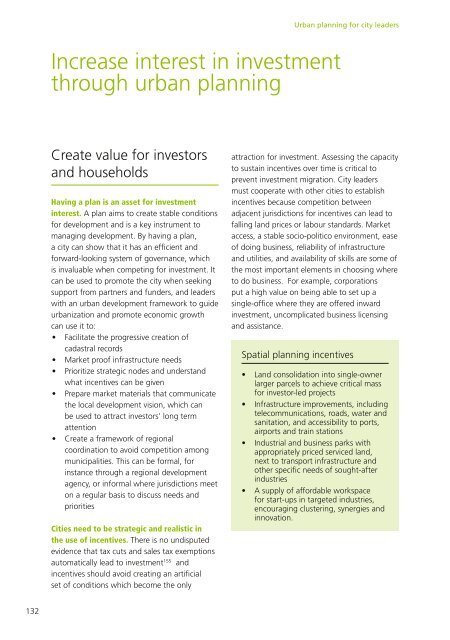Urban Planning for City Leaders - Cities Alliance
Urban Planning for City Leaders - Cities Alliance
Urban Planning for City Leaders - Cities Alliance
Create successful ePaper yourself
Turn your PDF publications into a flip-book with our unique Google optimized e-Paper software.
<strong>Urban</strong> planning <strong>for</strong> city leadersIncrease interest in investmentthrough urban planningCreate value <strong>for</strong> investorsand householdsHaving a plan is an asset <strong>for</strong> investmentinterest. A plan aims to create stable conditions<strong>for</strong> development and is a key instrument tomanaging development. By having a plan,a city can show that it has an efficient and<strong>for</strong>ward-looking system of governance, whichis invaluable when competing <strong>for</strong> investment. Itcan be used to promote the city when seekingsupport from partners and funders, and leaderswith an urban development framework to guideurbanization and promote economic growthcan use it to:• Facilitate the progressive creation ofcadastral records• Market proof infrastructure needs• Prioritize strategic nodes and understandwhat incentives can be given• Prepare market materials that communicatethe local development vision, which canbe used to attract investors’ long termattention• Create a framework of regionalcoordination to avoid competition amongmunicipalities. This can be <strong>for</strong>mal, <strong>for</strong>instance through a regional developmentagency, or in<strong>for</strong>mal where jurisdictions meeton a regular basis to discuss needs andpriorities<strong>Cities</strong> need to be strategic and realistic inthe use of incentives. There is no undisputedevidence that tax cuts and sales tax exemptionsautomatically lead to investment 155 andincentives should avoid creating an artificialset of conditions which become the onlyattraction <strong>for</strong> investment. Assessing the capacityto sustain incentives over time is critical toprevent investment migration. <strong>City</strong> leadersmust cooperate with other cities to establishincentives because competition betweenadjacent jurisdictions <strong>for</strong> incentives can lead tofalling land prices or labour standards. Marketaccess, a stable socio-politico environment, easeof doing business, reliability of infrastructureand utilities, and availability of skills are some ofthe most important elements in choosing whereto do business. For example, corporationsput a high value on being able to set up asingle-office where they are offered inwardinvestment, uncomplicated business licensingand assistance.Spatial planning incentives• Land consolidation into single-ownerlarger parcels to achieve critical mass<strong>for</strong> investor-led projects• Infrastructure improvements, includingtelecommunications, roads, water andsanitation, and accessibility to ports,airports and train stations• Industrial and business parks withappropriately priced serviced land,next to transport infrastructure andother specific needs of sought-afterindustries• A supply of af<strong>for</strong>dable workspace<strong>for</strong> start-ups in targeted industries,encouraging clustering, synergies andinnovation.132
















